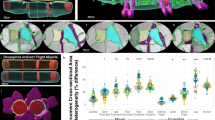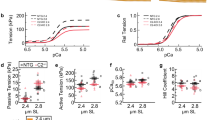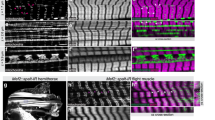Abstract
STRIATED muscles give a characteristic system of low-angle X-ray reflexions. These reflexions can be seen using preparations maintained in a normal physiological condition and still able to contract1,2. A number of axial reflexions can be observed in addition to the equatorial reflexions which arise from the hexagonal lattices of overlapping actin and myosin filaments1,3. Part of the axial pattern comes from the actin filaments and closely resembles the patterns given by oriented samples of purified actin4–6; in muscle, the most prominent feature here is a strong off-meridional reflexion at 59 Å. At smaller angles a number of reflexions corresponding to an axial period of approximately 435 Å are observed, and Worthington7, whose measurements are more accurate than the original ones1, has given good reasons for believing that they come from the myosin filaments. According to the sliding-filament model, passive changes in the length of the muscle are not accompanied by any changes in the lengths of either type of filaments, and so the original observation1 that all the axial reflexions are unchanged by passive stretch is precisely what we should expect.
This is a preview of subscription content, access via your institution
Access options
Subscribe to this journal
Receive 51 print issues and online access
$199.00 per year
only $3.90 per issue
Buy this article
- Purchase on SpringerLink
- Instant access to full article PDF
Prices may be subject to local taxes which are calculated during checkout
Similar content being viewed by others
References
Huxley, H. E., Ph.D. thesis, Univ. Cambridge (1952).
Huxley, H. E., Proc. Roy. Soc., B, 141, 59 (1953).
Hanson, J., and Huxley, H. E., Nature, 172, 530 (1953).
Astbury, W. T., and Spark, L. C., Biochim. Biophys. Acta, 1, 388 (1947).
Bear, R. S., and Selby, C. C., J. Biophys. Biochem. Cytol., 2, 55 (1956).
Cohen, C., and Hanson, J., Biochim. Biophys. Acta, 21, 177 (1956).
Worthington, C. R., J. Mol. Biol., 1, 398 (1959).
Page, S., and Huxley, H. E., J. Cell. Biol., 19, 369 (1963).
Page, S., Proc. Roy. Soc., B, 160, 460 (1964).
Author information
Authors and Affiliations
Rights and permissions
About this article
Cite this article
HUXLEY, H., BROWN, W. & HOLMES, K. Constancy of Axial Spacings in Frog Sartorius Muscle during Contraction. Nature 206, 1358 (1965). https://doi.org/10.1038/2061358a0
Issue date:
DOI: https://doi.org/10.1038/2061358a0
This article is cited by
-
A new twist on tropomyosin binding to actin filaments: perspectives on thin filament function, assembly and biomechanics
Journal of Muscle Research and Cell Motility (2020)
-
Obituary: Professor Gerald Elliott
Journal of Muscle Research and Cell Motility (2013)
-
The role of the myosin ATPase activity in adaptive thermogenesis by skeletal muscle
Biophysical Reviews (2011)
-
MusLABEL: a program to model striated muscle A-band lattices, to explore crossbridge interaction geometries and to simulate muscle diffraction patterns
Journal of Muscle Research and Cell Motility (2004)



